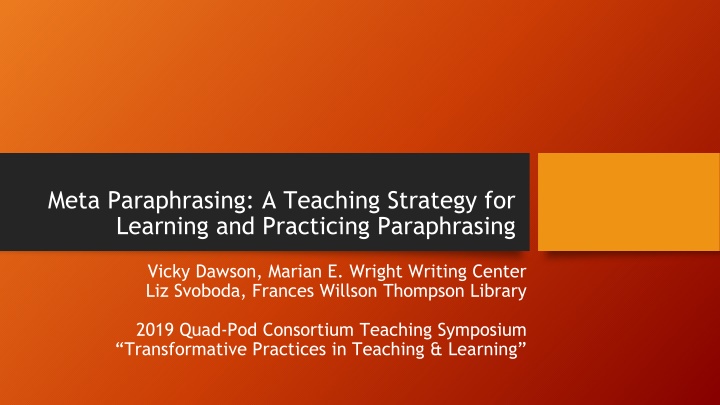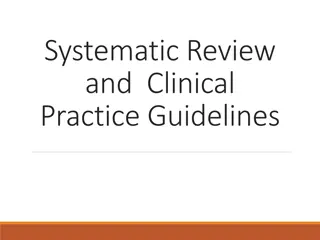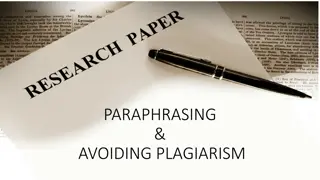Meta Paraphrasing: A Teaching Strategy for Learning and Practicing Paraphrasing
Paraphrasing is a vital skill that demonstrates understanding, allows integration of ideas ethically, and enhances credibility. This strategy involves proper analysis, using one's words, and citing sources accurately to avoid plagiarism.
Download Presentation

Please find below an Image/Link to download the presentation.
The content on the website is provided AS IS for your information and personal use only. It may not be sold, licensed, or shared on other websites without obtaining consent from the author.If you encounter any issues during the download, it is possible that the publisher has removed the file from their server.
You are allowed to download the files provided on this website for personal or commercial use, subject to the condition that they are used lawfully. All files are the property of their respective owners.
The content on the website is provided AS IS for your information and personal use only. It may not be sold, licensed, or shared on other websites without obtaining consent from the author.
E N D
Presentation Transcript
Meta Paraphrasing: A Teaching Strategy for Learning and Practicing Paraphrasing Vicky Dawson, Marian E. Wright Writing Center Liz Svoboda, Frances Willson Thompson Library 2019 Quad-Pod Consortium Teaching Symposium Transformative Practices in Teaching & Learning
The Marian E. Wright Teaching Circle on Plagiarism, 2019 This workshop is possible because of the generous support of Marian E. Wright (teaching circle sponsor) and the collaborative spirit of the Teaching Circle on Plagiarism team: Tracy Wacker (TCLT) Sandy Alberto (TCLT) Stephanie Roach (English Department) Liz Svoboda (Thompson Library) Vicky Dawson (Marian E. Wright Writing Center) Created by the Teaching Circle on Plagiarism 2019
Why is Paraphrasing Important? Shows you understand the material you borrowed Allows you to weave your voice into a conversation with your sources Gives your work greater credibility and trust Ensures you write ethically (Chapel Hill, 2019; Purdue OWL, 2019) Created by the Teaching Circle on Plagiarism 2019
What is Paraphrasing? Paraphrasing is first a mental process of analyzing and using the ideas and information of others by capturing accurately their ideas and information in your own words and sentence structure integrating their ideas and information to achieve your purpose Created by the Teaching Circle on Plagiarism 2019
Paraphrasing Is Ethical Writing Ethical writing is clear about whose ideas are being used and when they are being used. Strategies for Ethical Writing: Mention authors or titles within the paraphrase (some teachers call these voice markers or signal phrases ) Example: According to Smith . . . Clearly indicate if words from the original have been used by including quotation marks around word for word phrases Cite sources of the paraphrase both within the writing and at the end of the document using the assigned citation style (MLA, APA, Chicago, etc.) Created by the Teaching Circle on Plagiarism 2019
Paraphrasing Involves Critical Thinking Read to understand: Discover the overall meaning of the original source Strategize: Select what information or ideas you want to emphasize in your paraphrase Decide what the information s role and function is in your paper Develop new wording and syntax structure Practice: Try different ways to communicate the author s information in a new way while maintaining the original meaning Tip: use verbs that capture accurately and fully what the source is doing. What is the source s real purpose and why does it matter? Created by the Teaching Circle on Plagiarism 2019
When paraphrasing, verbs help you focus on a source s purpose Verbs Argue Claim Conclude Explain Find Indicate Propose Show Suggest Phrases According to As opposed to As reported by Even though However In agreement with In keeping with In line with Just as Created by the Teaching Circle on Plagiarism 2019
This is where we get meta! Created by the Teaching Circle on Plagiarism 2019
Sample Paraphrase 1: Original Source: University of North Carolina at Chapel Hill (2019). Writing paraphrases. Retrieved from writingcenter.unc.edu/esl/resources/writing- paraphrases/ Paraphrasing is clearly restating in your own words the ideas or thoughts of another person. A paraphrase differs from a summary in scope. A summary usually conveys all of the main ideas of a text, while a paraphrase can convey just the main point or a small bit of the text, like a single paragraph or sentence. Created by the Teaching Circle on Plagiarism 2019
Meaning Making and Strategy 1. What meaning do you get from the original source? To me, it means don t copy word for word. Understand the overall idea and meaning; explain using my words and sentence structure. A paraphrase limited to specific chunks of information. 2. Strategize how you might paraphrase the bullet points? Simplify details, condense to make it shorter, and avoid author s exact words and sentence structure to make it unique. Created by the Teaching Circle on Plagiarism 2019
Sample Paraphrase (Cited in APA) Original Source: Paraphrasing is clearly restating in your own words the ideas or thoughts of another person. A paraphrase differs from a summary in scope. A summary usually conveys all of the main ideas of a text, while a paraphrase can convey the just main point or a small bit of the text, like a single paragraph or sentence (North Carolina at Chapel Hill, 2019). Resources from the Writing Center at the University of North Carolina at Chapel Hill (2019) suggest that a key difference between summary and paraphrase is that unlike summary, paraphrasing offers the opportunity to focus on a sentence or paragraph and clearly explain the author s meaning in an original way. Created by the Teaching Circle on Plagiarism 2019
Now, its your turn. Created by the Teaching Circle on Plagiarism 2019
Sample Paraphrase 2: Original Source: Purdue OWL, 2019 "6 Steps to Effective Paraphrasing Reread the original passage until you understand its full meaning. Set the original aside, and write your paraphrase on a note card. Jot down a few words below your paraphrase to remind you later how you envision using this material. At the top of the note card, write a key word or phrase to indicate the subject of your paraphrase. Check your rendition with the original to make sure that your version accurately expresses all the essential information in a new form. Use quotation marks to identify any unique term or phraseology you have borrowed exactly from the source. Record the source (including the page) on your note card so that you can credit it easily if you decide to incorporate the material into your paper. Created by the Teaching Circle on Plagiarism 2019
Sample Meaning Making and Strategy Meaning Making: The author is suggesting a writer spend time with the information to fully understand it, then move away from the original text to see how one might be able to explain it in one s own words, even suggesting brief notes to ensure one doesn t get too fixated on the original phrasing. Strategy for Paraphrasing: Look at the concepts. What do the bullets have in common? What is the message from the author? Are the details important or is it the concept? Maybe generalize some of the concepts into process rather than steps? Created by the Teaching Circle on Plagiarism 2019
Sample Paraphrase (cited in APA) According to Purdue OWL (2019), paraphrasing can be accomplished through a process approach. This process emphasizes time: time spent on finding the meaning of a passage and five additional practice techniques to help guide saying it in one s own words. Created by the Teaching Circle on Plagiarism 2019
Take-Away Paraphrasing is a critical thinking skill that takes time and practice to learn and do well. Created by the Teaching Circle on Plagiarism 2019
References The Writing Center, University of North Carolina Chapel Hill (2019). Writing paraphrases. Retrieved from https://writingcenter.unc.edu/esl/resources/writing-paraphrases/ Purdue University, Purdue Online Writing Lab (OWL) (2019). Paraphrase: Write it in your own words. Retrieved from https://owl.purdue.edu/owl/research_and_citation/using_research/quot ing_paraphrasing_and_summarizing/paraphrasing.html Created by the Teaching Circle on Plagiarism 2019
Contact This PowerPoint was developed by the Marian E. Wright Writing Center and the Teaching Circle on Plagiarism 2019. For questions or additional resources, contact the Marian E. Wright Writing Center and Teaching Circle representative, Vicky Dawson vidawson@umich.edu This PowerPoint and other resource materials developed by the Teaching Circle on Plagiarism will be made available on the University of Michigan- Flint Writing Center s Faculty Support & Resources page. Created by the Teaching Circle on Plagiarism 2019























